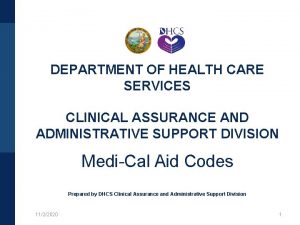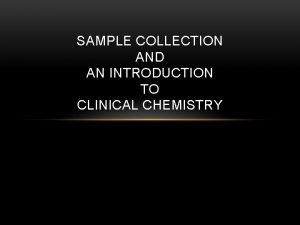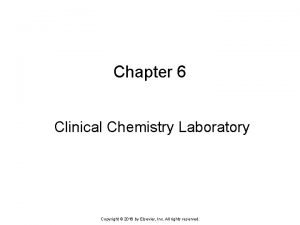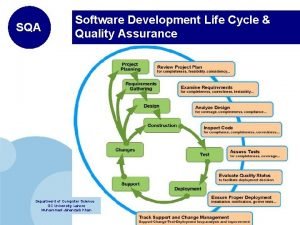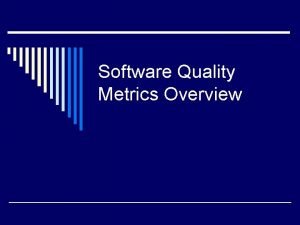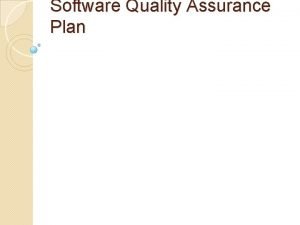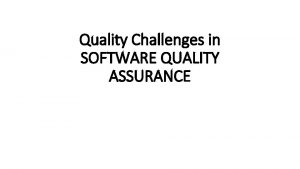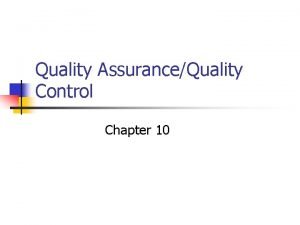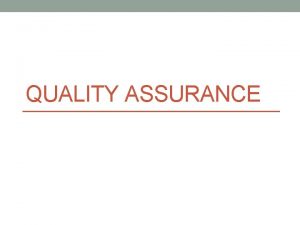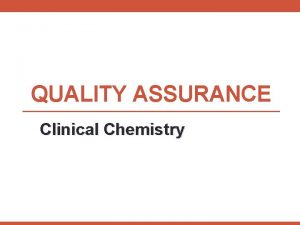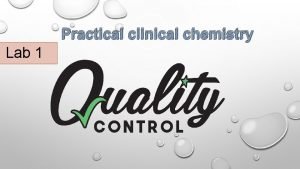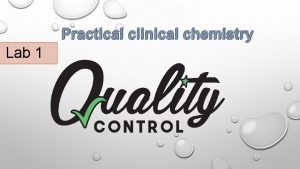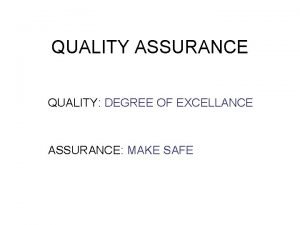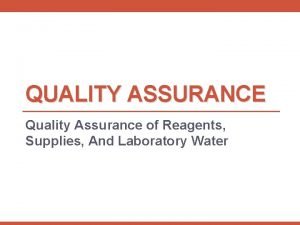QUALITY ASSURANCE Clinical Chemistry Many of the quality





















- Slides: 21

QUALITY ASSURANCE Clinical Chemistry

• Many of the quality assurance and quality control procedures and techniques already discussed were first developed for the chemistry laboratory and later applied to other areas of the clinical laboratory • Shewhart and Levey-Jennings control charts, • statistical multi-rule evaluation of control results, • evaluation and comparison of analytical methods, • procedure manuals, • and preventive maintenance procedures have long been familiar to technologists in the chemistry laboratory • To avoid unnecessary duplication, only those topics that are specific for the clinical chemistry laboratory will be discussed in this chapter 2

Specimen Collection and Sample Quality • Serum or plasma collected by venipuncture or capillary puncture is the sample of choice for the majority of chemical methods • specimen be collected without an anticoagulant, producing serum • other methods require that a preservative or anticoagulant be used to • Other tests on other fluids are also ordered • chemical analysis of urine • a limited number of tests are being applied to cerebrospinal fluid and other body fluids • for example, glucose and protein tests • Regardless of the specimen, it should be properly collected, preserved, and transported to the laboratory • The specimen should be accurately identified with the patient's name, history number, the date and time of collection, and the initials of the person collecting the sample 3

Collection & Transportation • Sodium fluoride • For samples which is necessary to completely stop glycolysis • Urine samples (24 h) • Preservation with boric acid or hydrochloric acid to prevent loss of various metabolites • Transportation of samples to Lab. should be as soon as possible • Some samples should be transported on ice • blood gases (O 2 levels decrease while CO 2 levels increase) • Some plasma constituents are photosensitive • Bilirubin measurement • Excessive vibration or rough handling • Hemolysis 4

Separation of Serum or Plasma • Once sample is received, it should immediately centrifuged to separate serum or plasma otherwise many changes can occur: • RBCs loose their integrity and intracellular components start to leak • Glucose and O 2 concentration decrease • CO 2, lactic acid increase while p. H becomes more acidic 5

The Effects of Hemolysis • Causes release of RBCs components which will increase the plasma concentrations of: • Potassium • Magnesium • Inorganic phosphorus • Copper • Lactate dehydrogenase • Aspartate transaminase • Alanine aminotransferase • Creatinine Kinase • Acid phosphatase • Plasma Hb • Which will interfere with bilirubin determinations with any measurements made at 540 nm 6

Changes due to storage of whole blood at RT Constituent Change in concentration Ammonia Marked increase Bilirubin Mild to marked decrease Total CO 2 Marked increase Carbonic acid Marked increase Ketone bodies Marked increase Lactic acid Marked increase Magnesium Mild increase O 2 Marked decrease Glucose Decreases Plasma enzymes Mild to marked decrease in activity Protein, sodium, chloride, Creatinine, Calcium Unchanged 7

Sources of Error in Clinical Chemistry 1. Specimen mix-up A. A Specimen drawn from wrong patient B. Specimen labeled with the wrong name or accession numbers C. Serum transferred into mislabeled tubes D. Improper cup placed into a tray position and the results reported on the wrong patient 2. Allowing evaporation of a sample while it sits on the analyzer waiting to be analyzed • This will concentrate the sample, resulting in higher values 3. Dilution and calculation errors a) b) Incorrect dilution of sample Failure to correct for dilution 8

Sources of Error in Clinical Chemistry 4. Sampling errors • Partially clotted specimen • Short sampling • Air bubble in the bottom of the cup • Fibrin clot in the sample probes 5. Transcription errors 6. Instrument losing calibration due to: • dirty reaction cuvettes, • or worn pump tubing; 7. Instrument is not recalibrated when new reagents are placed on the instrument • This can result in a shift in the calibration 9

QUALITY ASSURANCE IN THE TRANSFUSION SERVICE 10

• Quality Assurance in the Transfusion Service is of extreme importance • It does not depend on number ranges, date checks, or multi-rules for checking results • Additional attention is placed on the correct sample specifically that it is collected from the correct patients • Quality product must be made available for patient transfusion • Most institutions actually have a transfusion service rather than a blood bank • American Association of Blood Transfusion (AABB) standards for Quality assurance which most Blood Bank and transfusion Services follow 11

• The Safety and effectiveness of the transfusion given to the patient are important issues • Another important issues include: • result, • product safety and quality • and equipment performance • Blood component transfusions therapy is not less important than all of the Laboratory services • The measurement of the Factor VIII and Fibrinogen are important aspects of the Quality control 12

The Patient Blood Specimen • Accurate patient specimen Identification is very important • Data about patient should be attached firmly on label that includes: • Patient’s full name • Hospital number • Date the sample was drawn • Name of the phlebotomist • After the patient was identified correctly, other requirements are needed according to the test to be done on the patient's blood sample • The majority of blood bank tests are done on blood sample without a serum separator as both serum and cells are need for most testing 13

The Patient Blood Specimen • To supply necessary numbers of the cells such as for antiglobulin testing, elution's and cell separations; anticoagulant sample are needed sometimes • The anticoagulant used is not important because the cells are washed before making the test • We should put always on mind that the antigens of Red cells drawn in EDTA starts to deteriorate after 48 hours • Sterile tubes are not required for blood bank testing 14

Requisitions • There are two basic procedures that must be considered by blood bank and transfusion service when designing requisitions: • Firstly: The pre-transfusion blood typing information must be available to persons administering blood components • ABO, Rh type • Secondly: certain and accurate information about both the patient and the donor must be labeled and attached firmly to the individual component for transfusion 15

Blood Component labeling and transfusion Records • When a blood component is issued for transfusion, specific information is placed on the blood transfusion form • Many institutions choose to include all of the data on a single form, other will use one for the component and a separate requisition for the chart • The transfusion form to be placed in the patients chart must show the: • recipient name, • hosp. ID NO. , • ABO and Rh types, • Name of component, • Donor ID No. , • Donor ABO and Rh, • Tech. ID NO. if crossmatch was performed, • interpretation of the antibody screening • and viral tests 16

The label attached to the blood component • The label attached to the blood component must include: • Patient Name • Hosp. ID No. • Donor No. • the interpretation of the crossmatch • Tech. ID, • name of component, • ABO and Rh types of donor and recipient • The label attached to the unit should be a tie tag, or a sticky label that is part of the transfusion form 17

Procedure Manual • Blood bankers have been leaders in the development of procedure manual • The (AABB) Published a comprehensive volume of procedures entitled “Technical manual for blood banking” is the best of theory and practice of blood component therapy • The Technical manual may certainly be referenced in appropriate instances, however it may not be only procedure manual in the laboratory 18

Reagents • In the past, some hospital blood bank and transfusion services used as much reagent to complete the daily control testing as they used for all the patients sample • Because all licensed blood bank reagents must pass stringent exam prior to release for customer purchase • But we are required to make sure that the reagents are working as they should • No longer is it appropriate to spend more time and money on quality assurance testing than the patient testing 19

Reagents • Red cell containing reagents must be inspected visually for any hemolysis, the reagent, its lot No. and expiration date should be reported to the supplier if deterioration is suspected • For antisera reagents, both a positive and negative control must be run to assure that the reagent in question is reacting as intended 20

Quality Assurance of instrumentation • Because blood and its components are perishable products, close attention must be paid to: • Refrigerators for blood and reagent storage • Range 1 -6 o. C, equipped with an alarm • Recording chart from day to day • and thermometers should be calibrated yearly • Centrifuges should be calibrated 21
 Neqapp
Neqapp Perform quality assurance
Perform quality assurance Plan quality management pmp
Plan quality management pmp Quality metrics pmp
Quality metrics pmp Ana quality assurance model
Ana quality assurance model Quality improvement vs quality assurance
Quality improvement vs quality assurance Quality assurance concepts
Quality assurance concepts Dhcs aid code master chart 2020
Dhcs aid code master chart 2020 Introduction to clinical laboratory
Introduction to clinical laboratory Difference between end point and kinetic reaction
Difference between end point and kinetic reaction Npn clinical chemistry
Npn clinical chemistry Sqa software development
Sqa software development Quality assurance theory
Quality assurance theory Software quality assurance metrics
Software quality assurance metrics Software quality assurance iso standards
Software quality assurance iso standards Software quality assurance plan documentation
Software quality assurance plan documentation Blood bank qc procedure
Blood bank qc procedure Software quality challenges
Software quality challenges Quality assurance definition
Quality assurance definition Iuqb
Iuqb Contoh kegiatan quality control di rumah sakit
Contoh kegiatan quality control di rumah sakit Pharmacovigilance quality assurance
Pharmacovigilance quality assurance







